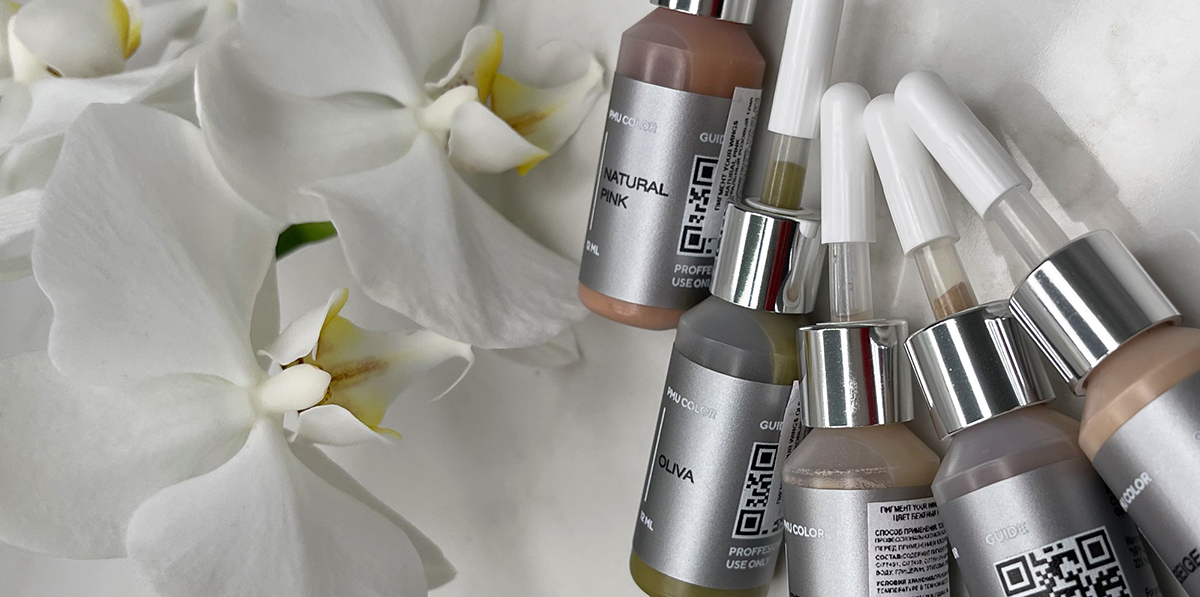What is the residue of YOURWINGS pigments?
This is probably the most frequently asked question about pigments. The residual values of YOURWINGS pigments vary. It depends on which collection you are using.

– Which type of pigment do you use?
To begin with, YOURWINGS has a mineral pigment collection as well as an organic pigment collection. and organic pigments and they behave very differently. For example, we use mineral pigments for the lips and mineral and organic pigments for the eyebrows. Mineral and organic pigments for the interciliary. We use mineral pigments for shadow shading, and mineral pigments only for work on the skin, areola or hairline.
– What does the residue depend on?
On average, mineral pigments have a residual value of ca. 80%, while organic pigments have almost 100% (all that is lost is in the crust and everything that’s applied to the dermis stays there). Of course, it’s important to understand that the percentage of residue depends not only on what pigments you take, but also on how tightly you place them in the skin and in general with what kind of skin you’re working on. For example, on scarred or vascular skin, the pigment care on healing may be more than you’d like. And this is completely normal.
– Is the residue that important?
Experience shows that the beauty and naturalness of the result is much more important than the residue, especially in the healed version, and even more importantly, months or years later. There’s no joy in a lip with 100% residue if permanent make-up doesn’t give it to a well-groomed appearance. Scar camouflage looks like a foreign paste if the pigment does not adjust to the skin’s texture. Techniques for stretching the eyelids with organic (“tattooing”) pigments – Tattoo pigments look great when fresh, but once they have healed they become a blurred, greasy bluish colour. They turn into blotchy, greasy blue pixels. We’ve all seen a lot of ruined of clients’ faces and shoddy work. Sometimes, on the contrary, you want the rest to be so that it’s not so difficult to remove.
– What distinguishes good pigments?
It is very important to understand that each pigment has to comply with its its intended use. Take Yourwings mineral lip pigments. They have, on average, a residual of 80%. It’s not 100%, but there’s absolutely no styling problem with them, and the overlapping ability is amazing. Not only that, they have a completely different look. If you redo a client’s work with mineral pigments after the organic ones, you simply can’t fail to notice the improvement in the skin quality of the lips.
With Yourwings eyebrow and eyelid pigments, you’ll never get grey, bluish eyebrows or blue-eyed arrows after a while if you work properly and in the right skin layers. Clever colour mixes simply eliminate such problems. Here it’s important to understand that in most cases we don’t use organic pigments. For shadow effects we do not use organic pigments, as there are completely different pigments available for this.
The shadow pigments for flat-out effects naturally have a lower residual percentage in terms of healing, because their purpose is to create a fine veil effect, a natural play of light and shadow without any hint of excessive
YOURWINGS’ camouflage pigments, on the other hand, are very low maintenance, as durability is important in leather work. In contrast, care is very low, because durability is important in leather work. It can be stated that with these pigments, practically anything that is applied to the leather will stay in the leather. But it’s not just about staying power. Their is that on the one hand they have a very strong covering power and, on the other hand, they don’t have the effect of being too dense or too smeary. In camouflage work this advantage cannot be overestimated.
Tricho pigments – what are they good for? Because they leave you margin for error precisely because they have a slight pullback in colour after healing. Trichopigmentation is a very difficult procedure, and few people get it done perfectly. But with Yourwings pigments, even if you overdo it a little bit, and you get a little too deep, you don’t ruin the person’s life, because…
after a while, the hairs you’ve drawn will lighten in proportion to and any imperfections will be less noticeable. The most important thing is that the pigments are beautiful afterwards! Remember that our work will stay on our clients’ faces forever. And it depends only on us, whether they will still still be pleasing after a while, or become a cause for dissatisfaction and extra hassle removal.
